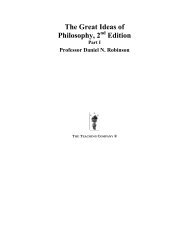English idioms in the first language and second language lexicon: a ...
English idioms in the first language and second language lexicon: a ...
English idioms in the first language and second language lexicon: a ...
Create successful ePaper yourself
Turn your PDF publications into a flip-book with our unique Google optimized e-Paper software.
Beate Abel 331representation <strong>and</strong> by <strong>the</strong> Idiom Decomposition Hypo<strong>the</strong>sis (Gibbs<strong>and</strong> Nayak, 1989). One of <strong>the</strong> central questions was whe<strong>the</strong>r dur<strong>in</strong>gidiom comprehension <strong>the</strong> literal or <strong>the</strong> figurative mean<strong>in</strong>g isretrieved. A related question has been <strong>in</strong> which order <strong>the</strong> differentmean<strong>in</strong>gs are accessed, if both mean<strong>in</strong>gs are retrieved. There arethree prom<strong>in</strong>ent studies that experimentally tested <strong>the</strong>se questions<strong>and</strong> that can be referred to as <strong>the</strong> ‘<strong>first</strong> generation’ of idiomprocess<strong>in</strong>g hypo<strong>the</strong>ses. These are <strong>the</strong> Idiom List Hypo<strong>the</strong>sis(Bobrow <strong>and</strong> Bell, 1973), <strong>the</strong> Lexical Representation Hypo<strong>the</strong>sis(Sw<strong>in</strong>ney <strong>and</strong> Cutler, 1979) <strong>and</strong> <strong>the</strong> Direct Access Hypo<strong>the</strong>sis(Gibbs, 1980). All three hypo<strong>the</strong>ses fundamentally rely on <strong>the</strong> ideathat <strong>the</strong> mean<strong>in</strong>g of an idiom is stored <strong>in</strong> a separate mental idiomlist (We<strong>in</strong>reich, 1969). First, Bobrow <strong>and</strong> Bell (1973) wanted toga<strong>the</strong>r evidence of two separate modes of process<strong>in</strong>g, a literal <strong>and</strong>a figurative one. The participants <strong>in</strong> <strong>the</strong>ir study were asked to<strong>in</strong>dicate which mean<strong>in</strong>gs of <strong>the</strong> two <strong>the</strong>y process <strong>first</strong>. Although acloser look at <strong>the</strong>ir results shows that <strong>the</strong>y did not f<strong>in</strong>d significantdifferences, Bobrow <strong>and</strong> Bell’s study has been cited ever s<strong>in</strong>ce asevidence for <strong>the</strong> existence of two separate modes of process<strong>in</strong>g.Accord<strong>in</strong>g to <strong>the</strong> authors, <strong>the</strong> literal mean<strong>in</strong>g is accessed <strong>first</strong> <strong>and</strong>only after its rejection is <strong>the</strong> idiomatic mean<strong>in</strong>g retrieved. Secondly,Sw<strong>in</strong>ney <strong>and</strong> Cutler (1979) assumed parallel activation of both <strong>the</strong>literal <strong>and</strong> <strong>the</strong> figurative mean<strong>in</strong>g with <strong>the</strong> idiomatic one hav<strong>in</strong>g aprocess<strong>in</strong>g advantage because it is fixed <strong>and</strong> is stored <strong>in</strong> a separatelist. The authors <strong>in</strong>terpreted <strong>the</strong>ir results as evidence <strong>in</strong> favour of<strong>the</strong>ir hypo<strong>the</strong>sis. Follow-up studies yielded support<strong>in</strong>g f<strong>in</strong>d<strong>in</strong>gs(Estill <strong>and</strong> Kemper, 1982; Glass, 1983; Botelho da Silva <strong>and</strong> Cutler,1993) <strong>and</strong> contradictory evidence (Burt, 1992).Thirdly, Gibbs (1980)assumed that an idiom’s figurative mean<strong>in</strong>g can be activatedwithout <strong>the</strong> literal mean<strong>in</strong>g be<strong>in</strong>g processed <strong>first</strong>. His studies haveshown that, given an appropriate context, <strong>the</strong> idiomatic mean<strong>in</strong>g isprocessed faster than <strong>the</strong> literal mean<strong>in</strong>g (see also Gibbs, 1985;1986; Schweigert, 1986; Schweigert <strong>and</strong> Moates, 1988; Needham,1992).A more recent hypo<strong>the</strong>sis, <strong>the</strong> Configuration Model (Cacciari<strong>and</strong> Tabossi, 1988; Tabossi <strong>and</strong> Cacciari, 1988), dispenses with <strong>the</strong>strict separation <strong>and</strong> ei<strong>the</strong>r–or question of literal or figurativemean<strong>in</strong>g. These studies have shown that <strong>the</strong> literal mean<strong>in</strong>gs of <strong>the</strong>constituents of an idiom are activated <strong>and</strong> stay activated dur<strong>in</strong>gprocess<strong>in</strong>g. The process<strong>in</strong>g of <strong>the</strong> idiomatic mean<strong>in</strong>g starts 300 msafter <strong>the</strong> presentation. The Configuration Model claims that <strong>the</strong>idiomatic configuration is recognized via <strong>the</strong> activation of <strong>the</strong>idiomatic key. The configuration takes its specific idiomatic mean<strong>in</strong>gwhile <strong>the</strong> literal mean<strong>in</strong>gs are still be<strong>in</strong>g activated. Depend<strong>in</strong>g onDownloaded from http://slr.sagepub.com at Shanghai Jiaotong University on March 7, 2009














